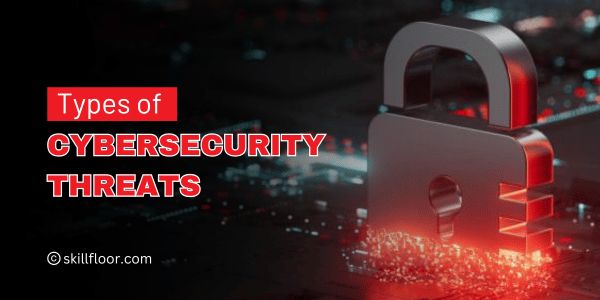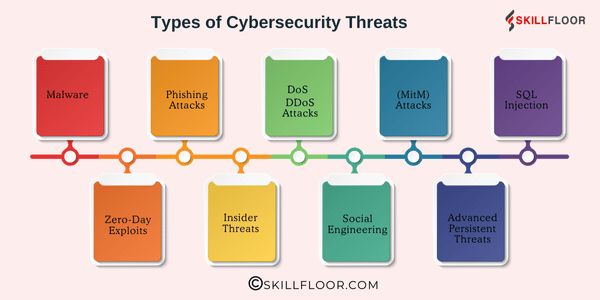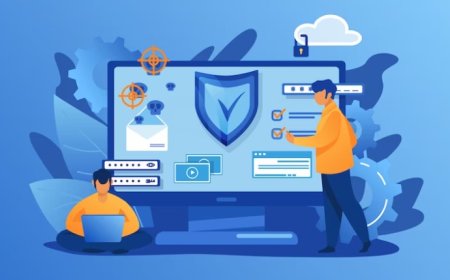Types of Cybersecurity Threats
Cybersecurity threats are real and growing. Learn about malware, phishing, ransomware, and more to protect your data before it's too late. Stay secure today!

Let me take you on a journey into the world of cybersecurity threats. Most people don’t think about these things until something bad happens, but trust me—it’s so much better to know about them now than to regret it later.
In today’s world, where almost everything we do is online, the risks are real. You can’t ignore them anymore.
When I first started learning about cybersecurity, I was surprised by how many different types of threats there are. Some, like fake emails trying to steal your passwords (phishing), were easy to understand. But others, like advanced attacks or zero-day exploits, really surprised me.
By the end of this, you’ll have a good idea of the types of cybersecurity threats and how they can mess with your life if you’re not careful. Let’s get started!
Why Should You Care About Cybersecurity Threats?
Here’s the thing: most people think, “I’ll never be a target of a cyberattack,” but that’s exactly what cybercriminals count on. They exploit ignorance. You’d be shocked to know that, according to recent studies, 43% of cyberattacks target small businesses, assuming they lack the resources to protect themselves.
Whether it’s your data being sold on the dark web, your bank account drained by a phishing scam, or your company’s operations halted by ransomware—cybersecurity threats don’t discriminate. And if you’re thinking, “I don’t have anything worth stealing,” let me burst that bubble right now. Your identity, credentials, and personal information are more valuable than you think.
Let’s Talk About the Types of Cybersecurity Threats
Now, let me break it all down for you. Here are the most common (and scariest) cybersecurity threats you need to know about:
1. Malware (Malicious Software)
If I had a dollar for every time I heard about malware, I’d probably retire early. Malware is the most common type of cyber threat, and it comes in many forms. The term covers everything from viruses to ransomware to spyware. Each type of malware serves a different purpose, but they all share one goal: to infiltrate and harm your device or network.
Let me give you a quick rundown of the most common types of malware:
-
Viruses: These attach themselves to files and spread like wildfire, corrupting everything in their path.
-
Trojans: They hide inside seemingly legitimate programs and trick you into installing them.
-
Ransomware: This is the nightmare scenario where your data is locked, and you’re forced to pay a ransom to regain access.
-
Spyware: It silently spies on you, collecting sensitive information like passwords and credit card details.
Imagine waking up one morning to find that every file on your laptop has been encrypted by ransomware. This isn’t science fiction—it’s happening every day.
2. Phishing Attacks
Phishing is one of those threats that makes me furious because it preys on human nature—our trust. Have you ever received an email that looks legitimate but asks for your login details? That’s phishing in action.
Here’s the scariest part: 93% of successful breaches start with phishing. Cybercriminals have perfected this art. They can make their emails look like they’re from your bank, your employer, or even your best friend.
It happened to me once—an email pretending to be from my bank asked me to “verify my account.” The email had the logo and the tone—it looked real. However, a closer inspection revealed the sender’s address was a random, unrelated domain. That one moment of caution saved me from what could have been a financial disaster.
3. Denial-of-Service (DoS) and Distributed Denial-of-Service (DDoS) Attacks
Ever visited a website, only to find it’s completely down for no apparent reason? That could be the result of a DoS or DDoS attack. In these scenarios, attackers flood a system with so much traffic that it crashes.
Now, you might think, “Why should I care about a company’s website being down?” But imagine if you’re running a small online business, and your site becomes the target of a DDoS attack. It’s not just annoying—it’s costly. Every minute your site is down could mean lost revenue and frustrated customers.
4. Man-in-the-Middle (MitM) Attacks
Picture this: You’re sipping coffee at your favorite café, connecting to the free Wi-Fi to check emails. Unbeknownst to you, a hacker is intercepting everything you do online. That’s a man-in-the-middle attack.
These attacks happen when a cybercriminal positions themselves between you and a legitimate entity, like a website or service. They can intercept data, steal credentials, or even manipulate what you see.
If you’ve ever used public Wi-Fi without a VPN, you’ve unknowingly put yourself at risk for MitM attacks. It’s a terrifying thought, isn’t it?
5. SQL Injection
This one’s a bit more technical but equally dangerous. SQL injection attacks target websites or applications that use databases. Attackers exploit vulnerabilities in the code to gain unauthorized access to sensitive data.
Here’s a fact that blew my mind: SQL injections account for nearly 65% of all web application attacks. Think about all the sensitive information stored in databases—names, addresses, payment details. It’s a goldmine for hackers.
6. Zero-Day Exploits
Zero-day exploits are like ticking time bombs. They occur when hackers find vulnerabilities in software before developers have a chance to patch them. These are particularly dangerous because there’s no defense against them until they’re discovered.
The term “zero-day” comes from the fact that developers have zero days to fix the issue before it’s exploited. These exploits often target popular software, making them a widespread threat.
7. Insider Threats
This one hits close to home because it’s about trust. Insider threats happen when employees or trusted individuals misuse their access to harm a company. Whether it’s a disgruntled employee leaking data or someone accidentally falling victim to phishing, the consequences can be devastating.
Statistics show that 34% of breaches involve insiders. It’s not always malicious; sometimes it’s just negligence. But either way, the impact is the same.
8. Social Engineering
If I could stress one thing, it’s this: cybersecurity isn’t just about technology—it’s about people. Social engineering attacks manipulate human behavior to gain access to systems or data.
For example, someone might call pretending to be from your IT department, asking for your password. Or they might leave a USB drive in a parking lot labeled “Confidential.” Curiosity gets the best of someone, and bam—the attacker gains access.
Social engineering preys on our instincts—our desire to help, our curiosity, and sometimes our fear.
9. Advanced Persistent Threats (APTs)
APTs are the stuff of spy movies. These are prolonged, targeted attacks where hackers gain access to a network and stay there undetected for months or even years. Their goal? To steal sensitive data over time.
These are often carried out by nation-state actors or highly organized groups. If you think this only happens to governments or large corporations, think again. Many smaller companies are targeted as a way to access larger organizations in the supply chain.

Example: The WannaCry Ransomware Attack (2017)
In May 2017, a big cyberattack called the WannaCry ransomware attack spread around the world. It targeted computers that hadn’t been updated with the latest security fixes. The attackers used a weakness in Windows computers to break in and lock people’s files. Then, they demanded money (in Bitcoin) to unlock the files.
This attack caused problems in over 150 countries. A good example is what happened in the UK’s National Health Service (NHS). Many hospitals couldn’t access patient records or use their systems. This meant appointments and surgeries were cancelled, making it harder for doctors to help patients.
The attack taught an important lesson: keeping your software updated is one of the best ways to stay safe from cyber threats.
Emerging Threats You Can’t Ignore
If you think we’ve covered it all, think again. Cyber threats are evolving every day. Some of the latest threats include:
-
AI-Powered Cyberattacks: Attackers are using AI to automate attacks, making them faster and harder to detect.
-
Deepfakes: Fake videos or audio clips that can deceive even the savviest users.
-
IoT Vulnerabilities: Your smart home devices, like cameras and thermostats, are potential entry points for hackers.
-
Cloud-Based Threats: As businesses migrate to the cloud, attackers are targeting poorly secured cloud environments.
Why This Matters to You
If all this sounds overcome, that’s because it is. Cybersecurity isn’t just an IT issue—it’s a personal issue, a business issue, and frankly, a societal issue. Imagine:
-
Losing years of personal memories stored on your laptop.
-
Watching your business come to a halt because of a ransomware attack.
-
Seeing your hard-earned money vanish because of a phishing scam.
It’s not just about the financial cost—it’s the emotional toll, the loss of trust, and the time it takes to recover.

How Do You Protect Yourself?
Don’t worry; I won’t leave you hanging. Here are some basic steps you can take to protect yourself:
-
Use Strong Passwords: Avoid predictable passwords like “123456.” Use a password manager to create and store unique passwords.
-
Enable Two-Factor Authentication (2FA): This adds an extra layer of security to your accounts.
-
Update Your Software: Those updates you keep postponing? They often contain critical security patches.
-
Be Wary of Suspicious Emails: If something seems off, don’t click links or download attachments.
-
Use Antivirus Software and Firewalls:
These provide a basic line of defense against most threats.
6. Educate Yourself and Your Team: Awareness is your greatest weapon against social engineering and phishing.
Final Thoughts
If there’s one thing I’ve learned, cybersecurity threats are not going away—they’re only getting more sophisticated. Ignorance is not bliss regarding your personal data, finances, or reputation.
The good news is that knowledge is power. Understanding the types of cybersecurity threats and taking proactive measures can significantly reduce your risk.
So, let me ask you this: Are you going to wait until it’s too late, or will you take steps now to protect yourself? The choice is yours. But I promise you, the peace of mind that comes with being prepared is worth every second of effort.





























































